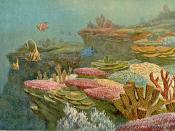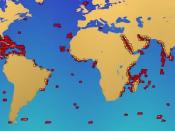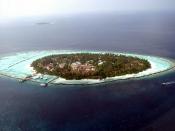Coral reefs are massive limestone structures, made from skeletons of millions of marine animals called coral polyps. As polyps die, new polyps grow on top and next to the dead ones. Many layers of skeletons from the dead polyps form the limestone structure of a coral reef. Other types of animals and plants also contribute to the structure such as: algae, sponge, and mollusks. They cover only 0.2% of the ocean floor and they are home to a quarter of marine plants and animal species. They live in warm, clear, shallow waters of tropical oceans.
The reefs are home to several species of marine animals such as the morays, eels, urchins and cucumbers, and many more. Fishers like to go fishing around the reefs to catch sharks, seahorses, and sea cucumbers for food markets, Chinese medicine, lobsters for tourist industry. They also help control erosion from seriously damaging the coast.
They act as a barrier and protect against storms.
The reef ecosystem is found along the coastal strip of at least 109 countries in the world, yet it has been calculated that the coral reef in at least 93 of these has already been gravely damaged or even destroyed. The coral reefs distributed over 60 percent of the Indian Ocean and Red Sea, 25 percent of the Pacific Ocean, and 15 percent of the Caribbean now risk disappearance. Human impact, climate change, global warming, pollution, and carbon dioxide are the causes for the disappearance.
Fisherman use dynamite and cyanide as a way to catch the reef animals. They do not realize what kind of damages they have created. The chemical stuns the fish, enabling live capture for restaurants and aquarium retailers, but kills corals. These fishers squirt cyanide into coral holes and crevices, where reef fish seek refuge. The cyanide...


